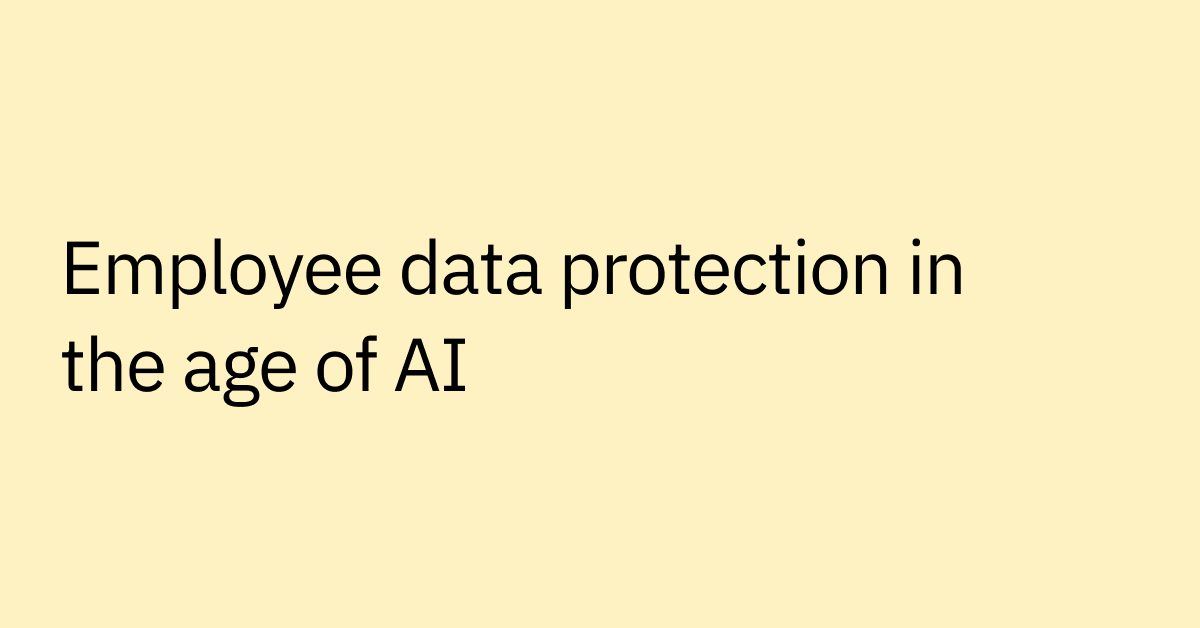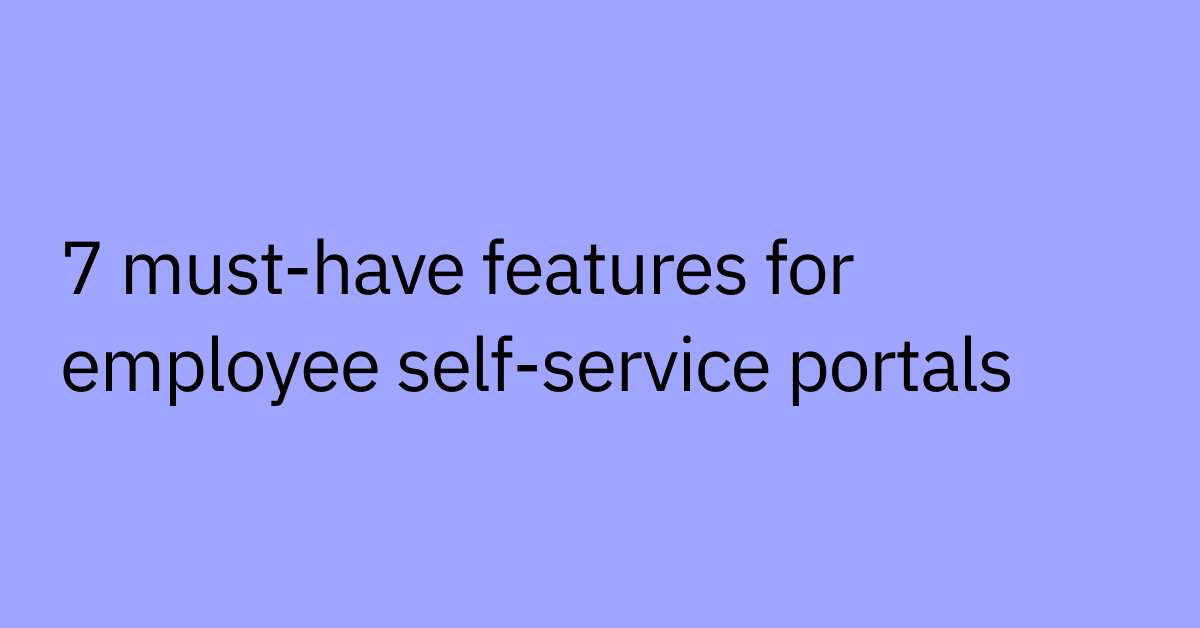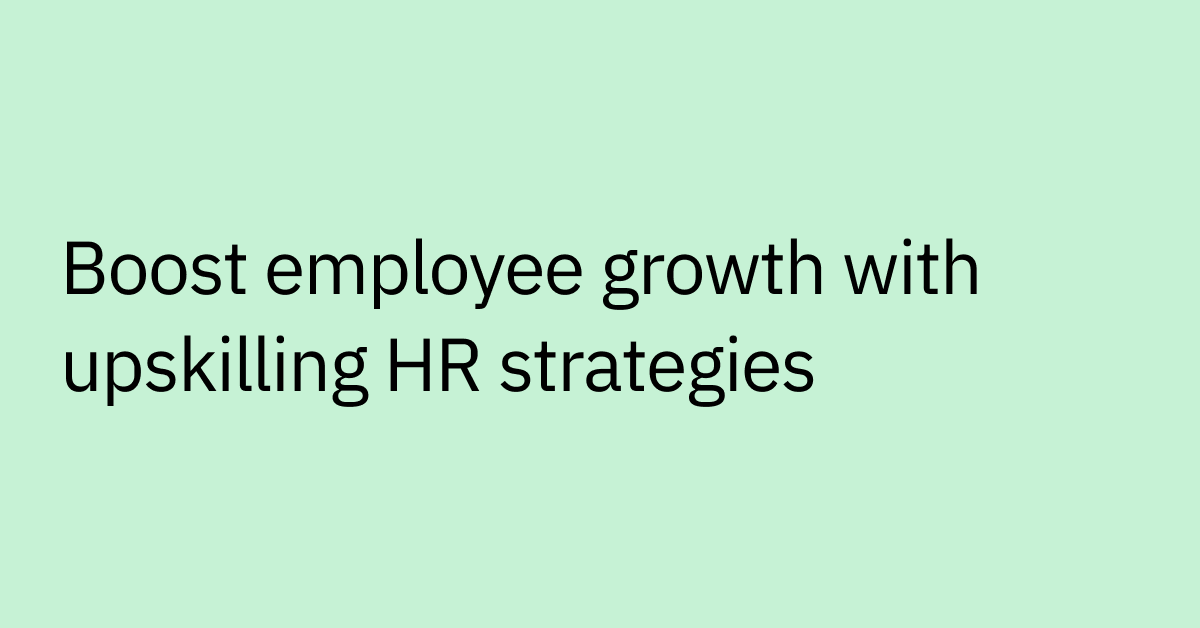Table of contents
What does the future of work look like to the most successful companies? If you peered into a crystal ball, I bet you’d see people at the heart of it all — the humans behind human capital.
As HR leaders look ahead to 2024, they must stay laser-focused on the everyday employee experience.
With AI and automation unlocking unprecedented potential across the employee lifecycle, HR service desks everywhere have an obligation to track how all of this change impacts people. Even as technology and talent transform, keeping employees engaged, empowered, productive, and thriving remains job number one.
AI will continue to bring unprecedented change to the working world. Tools like AI copilots, predictive analytics, and intelligent workflows have the potential to automate high-volume, repetitive tasks that drain HR bandwidth today.
By embedding AI into everything from recruiting and onboarding to performance management and learning, forward-looking CHROs can elevate their HR team while improving employees’ day-to-day.
That’s why HR leaders must prioritize metrics that track the human impact of automation. Whether you manage 10 or 10,000 employees, monitoring key benchmarks allows you to ensure technology speeds up — not slows down — experience.
Act now, not later. HR metrics matter today, not someday. Let's explore why they're crucial to your success in 2024 and how we can start moving key benchmarks in the right direction with AI.
What are the most important HR metrics?
What’s measured gets managed. But with countless metrics at our disposal today, it's crucial we zero in on the metrics that fuel strategic decisions.
I’ll start by calling out ten key HR metrics that are tablestakes. This quick list sheds light on the areas that matter most: hiring, retention, learning, compensation, and beyond. They enable people-centric leaders to ask the right questions, ignite the right conversations, and blaze trails for others to follow:
- Headcount: The number of employees actively working
- Turnover: The rate at which employees voluntarily leave and must be replaced
- Manager effectiveness scores: Benchmark ratings for people leaders based on turnover rates, span of control, and team output
- Diversity, equity, and inclusion (DEI): The proportion of workforce representation across gender, race, age, and other demographic factors, highlighting inclusion gaps
- Compensation: The total rewards or payment provided to employees in return for their work or services rendered to an organization
- Total cost of workforce (TCOW): The comprehensive expenditures related to employee payroll and benefits compensation
- Spans and layers: Organizational shape metrics that track reporting hierarchies, evaluating complexity and manager burden
- Talent acquisition: Metrics tied to critical recruiting funnel stages illuminating bottlenecks like time-to-fill rates, source of hire, and other efficiency measures.
- Learning efficacy: Uptake and efficacy rates on skill-building offerings indicating development program value.
- Work-life balance: Surveys or metrics assessing employees' perceived balance between work and personal life, influencing productivity and well-being.
These metrics serve as the backbone for assessing the operational effectiveness of your help desk. However, while each metric provides valuable insights, conversational AI tools have changed the game and given us new metrics to consider.
With that in mind, we recommend HR leaders focus on six measurements in 2024:
- HR query response time: The time it takes HR to address and resolve employee inquiries or concerns.
- Hours of productivity saved: The time, in work hours, that has been conserved or made more efficient through streamlined processes or automation.
- Time to productivity: The time it takes for new hires to reach full productivity.
- HR system adoption: The percentage of adoption and utilization of HR-related technology or systems among employees.
- Employee engagement: The percentage of employees committed and involved with their work and the organization.
- Knowledge base coverage: The percentage of HR-related topics or queries that are adequately covered within the knowledge base.
Today, I’ll dive deep into why each of these metrics matters in our increasingly AI-powered world. And I’ll show you how embracing these measures can empower HR teams to shake up their strategies for 2024 and beyond.
By embracing these metrics and tapping into intelligent automation's potential, HR isn’t just transforming operations — it's crafting an experience that uplifts employees. It’s about refining processes, enhancing how we work together, and paving the way for sustainable growth that benefits everyone in the organization.
Why do HR metrics matter?
HR metrics provide the key data points allowing organizations to monitor and optimize essential workforce functions. Business leaders can diagnose strengths, weaknesses, and opportunities requiring their attention by tracking critical benchmark indexes around recruitment, retention, compensation, development, and engagement activities.
In essence, HR analytics shine a spotlight on the health of a company's people operations. When metrics are acted upon, they create an employee experience where professionals feel motivated, valued, and able to thrive in their roles.
The seismic workplace shifts of recent years underscore the importance of listening to what the numbers tell us. As priorities rapidly evolve around flexibility, inclusion, well-being, and more, metrics enable people-first leaders to move at the pace of change.
Proactively analyzing HR data allows for more agile goal-setting and decision-making aligned to the cultural and capability requirements emerging across today's workforce. Rather than reacting to sudden swings, metrics-driven HR teams predict and shape better employee experiences.
In short, embracing HR metrics marks a crucial first step toward more strategic, responsive, and dynamic people success in times of turbulence and transformation. Their signals guide leaders to see around corners and charter the future of work — rather than getting left behind.
Without further ado, here are the six metrics to track in 2024…
Why track HR query response time?
Speed and accuracy in answering employee questions are vital for an effective HR function. By tracking query response metrics, leaders can better understand:
- Overall ticket volume to right-size staffing needs
- Common categories driving inquiries like payroll, time off, or healthcare
- Knowledge gaps that can inform learning programs
- Individual agent performance and coaching needs
- Opportunities to streamline processes or improve self-service access
Speed and accuracy in answering employee questions are vital for an effective HR function, as shown by chemical manufacturer Albemarle's example. By launching an HR chatbot to provide 24/7 support for 6,000 global employees, Albemarle was able to aggregate data across disconnected systems and resolve inquiries faster. This HR chatbot enabled data-driven insights and workforce digital transformation by streamlining common inquiries like payroll, time off, and healthcare.
This is to say that fast, consistent query resolution improves employee satisfaction, productivity, and retention. Establishing and monitoring core response time KPIs enables data-driven decisions to improve continuously.
How to improve HR query response time with AI
AI solutions can transform HR contact centers to resolve employee inquiries faster and more effectively:
- AI copilots can handle routine questions automatically around the clock, freeing agents for complex issues.
- AI-powered triage can accelerate complex issues by automatically routing questions to the right specialist or manager for approvals.
- Conversationalized workflows make it easier for employees to self-service their own support across multiple HR systems.
- AI analytics allow better insight into individual and team performance over time to drive continuous improvement.
Why track hours of productivity saved?
Tracking the number of hours of productivity saved by HR activities reveals how efficiently your team operates and where process improvements may lie. Understanding where employees spend time and what tasks ultimately move the needle on business goals allows leaders to:
- Identify areas of waste where outputs don't justify inputs
- Coach teams on prioritization and process discipline
- Advocate for automation, delegation, or outsourcing to focus efforts on value-add
- Reward high-performing individuals driving a work smarter, not harder culture
Cybersecurity leader Palo Alto Networks gained over 350,000 hours of productivity savings after deploying an HR copilot called Sheldon to support their distributed 15,000-person workforce. Sheldon resolved thousands of HR cases per month, freeing up staff for strategic priorities.
For Palo Alto Networks, understanding where employees spend time and what tasks ultimately moved the needle on business goals by helping leaders identify waste, coach teams on prioritization, and advocate for automation.
Every hour saved from administrative tasks, duplicative work, and distractions is an hour gained to undertake more strategic initiatives, critical thinking, and skill building to accelerate results.
How to improve hours of productivity saved with AI
AI has significant potential to free up capacity through increased workflow automation:
- Personalized employee onboarding provides guidance and networking.
- AI-driven training recommends skill-building content based on individual needs.
- Productivity dashboards can use AI to track and quantify the impact of learning programs on employee productivity and other metrics, allowing for the optimization of L&D spending and content improvement.
- Predictive analytics identify at-risk new hires for targeted intervention.
Why track time to productivity?
Understanding how long it takes for new hires to reach full productivity is a crucial workforce metric. Tracking time-to-productivity reveals:
- Onboarding program effectiveness
- Early capability gaps needing development
- Manager skills in supporting new employees
- Suitability of hires for the role/team
For example, AppDynamics experienced fast growth to over 2,300 employees, making providing high-quality yet cost-effective support during onboarding challenging. The company deployed an AI solution called AppDynoBot, which instantly resolved over 30% of employee issues without agent involvement — including new hire account setup.
By establishing targets and measuring against benchmarks, HR can continuously improve hiring and onboarding processes. This ensures new team members integrate successfully and swiftly deliver value.
How to improve time to productivity with AI
AI solutions can transform onboarding and upskilling programs to dramatically shorten new hire ramp-up:
- Personalized employee onboarding provides guidance and networking.
- AI-driven training recommends skill-building content based on individual needs.
- Productivity dashboards can use AI to track and quantify the impact of learning programs on employee productivity and other metrics, allowing for the optimization of L&D spending and content improvement.
- Predictive analytics identify at-risk new hires for targeted intervention.
Why track HR system adoption?
Monitoring employee adoption rates for new HR platforms and tools is essential for maximizing ROI on technology investments. Low utilization signals poor change management, confusing interfaces, or misalignment to actual workflows. Tracking adoption trends over time reveals:
- User drop-off points to minimize
- Opportunities to consolidate redundant systems
- Use cases not being met requiring customization
- Training gaps undermining engagement
When data storage provider Solidigm rolled out an HR chatbot to their 1,000-plus person global workforce, it became "the core of our digital workplace" by centralizing access to services across their HR apps. This AI-powered approach improved the experience and enabled HR to deliver more personalized, efficient support from day one.
Setting targets for active usage focuses stakeholders on driving platform success and continuous enhancement based on data.
How to improve HR system adoption with AI
AI can dramatically accelerate user onboarding and adoption of HR systems in several key ways:
- HR chatbots guide employees through initial registration and setup.
- In-application tips and assistants showcase platform capabilities.
- Contextual recommendations suggest relevant features based on individual activity.
- Advanced analytics let you dig deeper than ever before into how your investments in applications, systems, and support teams are performing.
- Multi-channel nudges and reinforcements boost habitual engagement.
Why track employee engagement?
Monitoring employee engagement — the level of satisfaction, discretionary effort, and emotional commitment people feel in their roles — provides indispensable insights into organizational culture and performance. Tracking engagement over time and across segments reveals:
- Hot spots and pain points
- Manager and team dynamics that need realignment
- Burgeoning or waning affinity to company purpose
- Opportunities to strengthen inclusion and belonging
For example, when leading healthcare provider Vituity deployed an HR copilot for their 5,000 physicians, it allowed doctors to get instant support without disrupting patient care — improving experience, productivity, and engagement. Tracking engagement over time and across segments revealed challenges as well as opportunities to strengthen engagement, like leveraging AI to craft personalized and targeted internal comms.
As engagement at Vituity increased, so did productivity, innovation, loyalty, and advocacy. Proactively assessing and addressing experience through data is key to a thriving, resilient workforce.
How to improve employee engagement with AI
AI solutions can provide richer engagement insights while identifying targeted interventions:
- Pulse surveys powered by natural language processing (NLP) deliver nuanced sentiment analyses
- Coaching tools issue prompts for better quality manager interactions
- Personalized internal comms increase task completion with action buttons that connect campaigns to workflows.
Why track knowledge base coverage?
Monitoring knowledge base coverage — the extent to which employee questions are addressed by existing support articles — is vital for maximizing self-service opportunities. While poor coverage leads to repeat inquiries flooding live channels, analyzing your knowledge base over time illustrates:
- New systems or services needing documentation
- Policy and process changes not being properly communicated
- Emerging employee pain points and needs
- Opportunities to consolidate diffuse information
For example, Broadcom had information spread across ten different knowledge bases, making it difficult for employees to find answers. By integrating these sources with an AI copilot, Broadcom enabled employees to self-serve 57% of IT issues in under 60 seconds.
Strong knowledge management is proven to dramatically boost IT ticket deflection rates. Setting targets for coverage based on trend analysis pushes teams to continuously expand the breadth and relevance of self-help content.
How to improve knowledge base coverage with AI
AI can rapidly strengthen both knowledge base depth and employee utilization:
- Generative AI autonomously drafts new articles on emerging topics to rapidly fill coverage gaps.
- AI analytics continuously monitor knowledge bases to identify outdated, irrelevant, or unhelpful content needing retirement or refresh.
- Natural language capabilities instantly translate existing articles into 100+ languages, breaking down barriers to self-service for global workforces.
- AI copilots understand context and proactively surface the most relevant snippets of articles to solve their specific issues.
- Location-based permissions enable relevant, compliant snippets to be shown according to the employee's office geography and data privacy regulations.
AI calls for new thinking on HR metrics in 2024
While HR metrics like turnover and recruiting velocity remain relevant, AI unlocks entirely new dimensions like query resolution rate, hours saved, knowledge base efficacy, and more.
The shifts we've discussed underscore how AI compels HR leaders to rethink the metrics guiding their function. And with AI adoption only accelerating, these “new” operational benchmarks will reveal how well HR teams are integrating and optimizing this technology.
Keeping track of these metrics is especially key for HR, where automating even basic responsibilities can be extraordinarily difficult given the complexity of policies, data, and systems.
Taming this complexity requires AI that understands context, interprets natural language, and acts decisively on employees' behalf. Moveworks' HR solution incorporates the latest advancements in machine learning to engage users conversationally at scale across channels.
The result is fast, frictionless support that delights employees. Any vendor can build a basic bot, but achieving true automation for every HR use case demands genuinely sophisticated AI. Moveworks possesses deep enterprise understanding coupled with cutting-edge technology to deliver immediate, easy support.
Why? Well, we’ve realized that small moments define how employees experience HR. When a quick policy clarification or benefits lookup becomes a frustrating time sink, it colors perception negatively. Our AI eliminates the disruptive small-moment headaches for both HR teams and staff by automating routine requests seamlessly.
As more leaders embrace automation, AI will transform HR's role by lifting the administrative burden. Teams can then form tighter strategic alliances with business leaders to nurture talent. AI enables HR staff to work in tight partnership with business leaders to evolve team structures, roles, and dynamics to help employees thrive and drive their companies forward.
Moveworks handles the busy work so you can focus on what matters: your people. Deliver HR help with AI.



